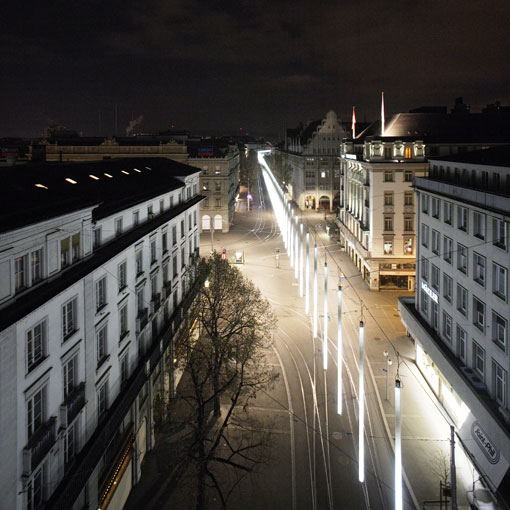A great example by Gramazio & Kohler how christmas lights could look in future; Here’s a short description by the architects themselves:
” ‘Distinctive, generous, unique’—these were some of the qualities expected of the Christmas illuminations in Zurich’s internationally renowned shopping street. ….We designed a continuous band of lights, 1.1 km long, using 275 tubes of light, which we called “The World’s Largest Timepiece”.
In terms of urban planning, the installation connects the railway station to the lake. Its simple, linear course turns the band of light into the visual backbone of the city, accentuating the appearance of the Bahnhofstrasse and its two slight yet distinct changes in direction. …

View at Paradeplatz; Photo by Roman Keller
Light Tubes
The 7 m high, round tubes had to provide light evenly in all directions, and be able to withstand heavy windloads despite being light in weight. We therefore had to find a rigid, robust casing material that would also transmit light.
Eventually we chose wound glass fibre technology: a special manufacturing process in which glass fibres are soaked in resin and spun around a mandrel. We were fascinated by the additive logic of this process. The winder controls the stacking of the fibres via two computer-coordinated movements. A sliding carriage drives the glass fibres back and forth along the spinning mandrel, creating an extremely stable multi-layered tube. The stacking winder and the number of tiers and overlappings determine the rod’s flexural rigidity and torsional stiffness, as well as its transmission of light. … The final tube was 7 m long and 15 cm in diameter, but its shell was only 2 mm thick; including the lighting and control technology, it weighed just under 23 kg. Intense engagement with the computer-operated production process allowed us to integrate two normally incongruent requirements into a single material, thus using wound glass fibres for lighting on this scale for the first time.
Xmas Generator
During the Christmas season the Bahnhofstrasse is illuminated for eight hours every night, with a constant flow of changing light sequences. Designing this 320-hour urban environment was an innovative, exciting and demanding task that stretched the classic architectural repertoire to include the algorithmic design of time-based sequences.
Thus the lights are “played” by custom software that controls the 8,800 LED bulbs in real time. We designed the parameters and rules of the algorithm to be potentially unlimited. The installation’s distinctive identity is conferred by the constant creation of new, unpredictable light patterns. Movement sensors affect the design and reflect what is going on below. But the Christmas lighting responds to people on the street gently and quietly, without overemphasising its interactivity.”
video by scharzpictures.com
via: gramaziokohler.com